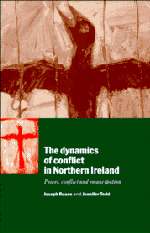Book contents
- Frontmatter
- Contents
- List of figures
- List of tables
- Preface
- 1 Introduction
- 2 Historical formations
- 3 The reconstruction of communal division
- 4 Ideology and conflict
- 5 The dynamics of conflict: politics
- 6 The dynamics of conflict: the economy
- 7 The dynamics of conflict: culture
- 8 The British context of the Northern Ireland conflict
- 9 The Republic of Ireland and the conflict in Northern Ireland
- 10 The international context
- 11 An emancipatory approach to the conflict
- Epilogue
- Appendix
- Bibliography
- Index of names
- Index of subjects
3 - The reconstruction of communal division
Published online by Cambridge University Press: 18 December 2009
- Frontmatter
- Contents
- List of figures
- List of tables
- Preface
- 1 Introduction
- 2 Historical formations
- 3 The reconstruction of communal division
- 4 Ideology and conflict
- 5 The dynamics of conflict: politics
- 6 The dynamics of conflict: the economy
- 7 The dynamics of conflict: culture
- 8 The British context of the Northern Ireland conflict
- 9 The Republic of Ireland and the conflict in Northern Ireland
- 10 The international context
- 11 An emancipatory approach to the conflict
- Epilogue
- Appendix
- Bibliography
- Index of names
- Index of subjects
Summary
The nineteenth century saw the emergence of two culturally and politically polarised communities in Ireland. Partition created new conditions for community formation, identity and solidarity, but deep communal polarisation has persisted. In this chapter we look at the dynamics of community formation in the post-partition period, describe community structure in Northern Ireland today and explore some of the ways in which that structure contributes to continuing communal polarisation.
The reconstruction of community, 1920s–1960s
Protestants
Protestants formed an island-wide community at the start of the twentieth century, sharing wider political goals and loyalties and bound by religious, cultural and social ties. The community was internally differentiated religiously and in class and regional terms. Ulster Protestants saw themselves and were recognised as different from Protestants in the other three provinces because of the strength of the Scottish and Presbyterian influence, their demographic majority, their participation in the industrial revolution and the presence of a stronger religious fundamentalism. From 1905, with the formation of the Ulster Unionist Council, their political strategy, organisation and proximate aims diverged from those of the Irish Unionists. Within Ulster itself, internal Protestant religious and class divisions were strong and Protestant settlement had a marked core–periphery form. East Ulster, with Belfast as its centre, had long been the core of Ulster Protestant economic and political life and culture, the area of densest Protestant population and closest links to Scotland and England. The farther one moved from the eastern core, the weaker and more fragmented Ulster Protestants became. At the periphery, Protestant Ulster extended into the wider Irish Protestant community centred on Dublin.
- Type
- Chapter
- Information
- The Dynamics of Conflict in Northern IrelandPower, Conflict and Emancipation, pp. 49 - 83Publisher: Cambridge University PressPrint publication year: 1996

